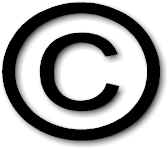Here is How You Protect Your Art
 Here is how you protect your art!
Here is how you protect your art!
The information provided below was in response to a question posted on our discussion in March of 2000. This reply, provided by Thunderer, has been edited — any errors or misinformation introduced were probably caused during this process. If you require any clarification, please visit our discussion board.
Listed below are ways you can protect yourself from copyright infringements, whether you be a lyricist, musician, author, painter, sculpture, performance artist, etc.. I hope this post may be of assistance to you (and others).
With regards to copyrights:
Any artistic arrangement and composition (music, lyrics, painting, sculpture, writing, performance, etc.) that is deemed "unique" (which maybe subject to debate) is protected the moment the artist has completed the work. Therefore, within Federal Law, the moment your daughter completes her project, it is legally hers and she is due all rights, privileges and protections the law would afford you. Copyright registration, although always advised, "technically" is not really required …provided you can prove you were the creator.
But the problem is if a copyright infringement occurs and there is debate over who originated the work, how does the court know who was the creator. That is why copyright registration is recommended, to provide national (and "limited" international) acknowledgement of who first wrote, drew, sang, performed, etc. the art. This would obviously provide the registrant with very persuasive evidence that they are the owner and are entitled to whatever fruit their efforts might bear. But know this, even though someone registers a copyright, if it can be proven someone else had actually created the art prior to the registration, that copyright can still be preempted or rescinded. Therefore, if you see, hear or become aware of your work being performed, sold, reproduced, etc. you would still have legal recourse, even if the infringer registers his/her work with the Library of Congress…
…again, provided you can prove you were the creator.
Here is something you may do on an interim basis to provide you with some in expensive protection. This is what my father-in-law did as he completed his musical/lyrical compositions/arrangements. As he finished songs, musical arrangements, compositions, and even only significant parts of what he was doing, he would create both a written/audio reproduction of his work and mail (US) it to himself.
When he received his self-addressed mail, he did not open the post-marked packages. He simply put the unopened packages into a safe place (e.g., safe, safety deposit box, etc.) and did not remove them unless he needed them to prove his ownership or after he had properly registered and received confirmation of the copyright registrations from Library of Congress.
Doing this would allow you to create hard evidence of what you have created for as little as the price of an envelope and stamp and a few moments of your time. Be sure not to open the package so as to maintain the integrity of the date (per the postmark) the work was created. (I might even do this in duplicate, to provide secondary proof should something happens to some of your mail.)
If the work is included on paper, on it I would explicitly state that I am the artistic creator, sign & date it (include the actual time of day too) and have someone else sign it as a witness. If the work is performed via audio, video, computer, etc. identify (verbally, visually) on the tape, CD, diskette, etc. that you are the creator, again, including your full name, date & time the work was created and witnesses.
Of course, using the mail to prove your authorship presumes you trust your local postal service will appropriately deliver the mail (which some of you may have reason not to). Therefore, another more time and cost-effective measure would to have the written reproduction of your work notarized. Again, simply reproduce your artistic renderings onto paper, state on it you are the creator of the poem, music, lyrics, etc., have it witnessed by another person and have a licensed notary stamp/date (including time of day). And again, put the notarized items away for safekeeping.
And perhaps a third form of ownership proof would be video and computer reproductions. Because both video tape and computer files lists the date and time the tape or file was created and saved, both would be a great tool for documenting music, lyrics, poems, etc. Of course, if would be vitally important that the files not changed or altered in a way that might change the dating on the tape or file.
Either of these three techniques or combinations of the three should provide you with adequate interim protection of your daughter’s work. And, of course, I advise she not publicly present any of her work until after she has performed at least one these three procedures. The Library of Congress charges $30 per Copyright Registration. However, the Library of Congress permits you to simultaneously register several similar works of art for what could be the price of only one work of art. Therefore, you can wait until after you have accumulated several similar kinds of projects (of course, after you have mailed, notarized, taped, or computerized them), package them together (e.g. via book form), then register them all together. If you are a fairly prolific author, poet, songwriter, etc. this method could be of great cost savings to you. This website will assist you with registering your:
https://www.copyright.gov/
And after you have registered her work with the Library of Congress, you may state on all flyers, letters and other public pronouncements of her works that it is copyright protected via the symbol ©
Related Links
Pros and Cons of Mainstream and Self-Publishing by C. Liegh McInnis
